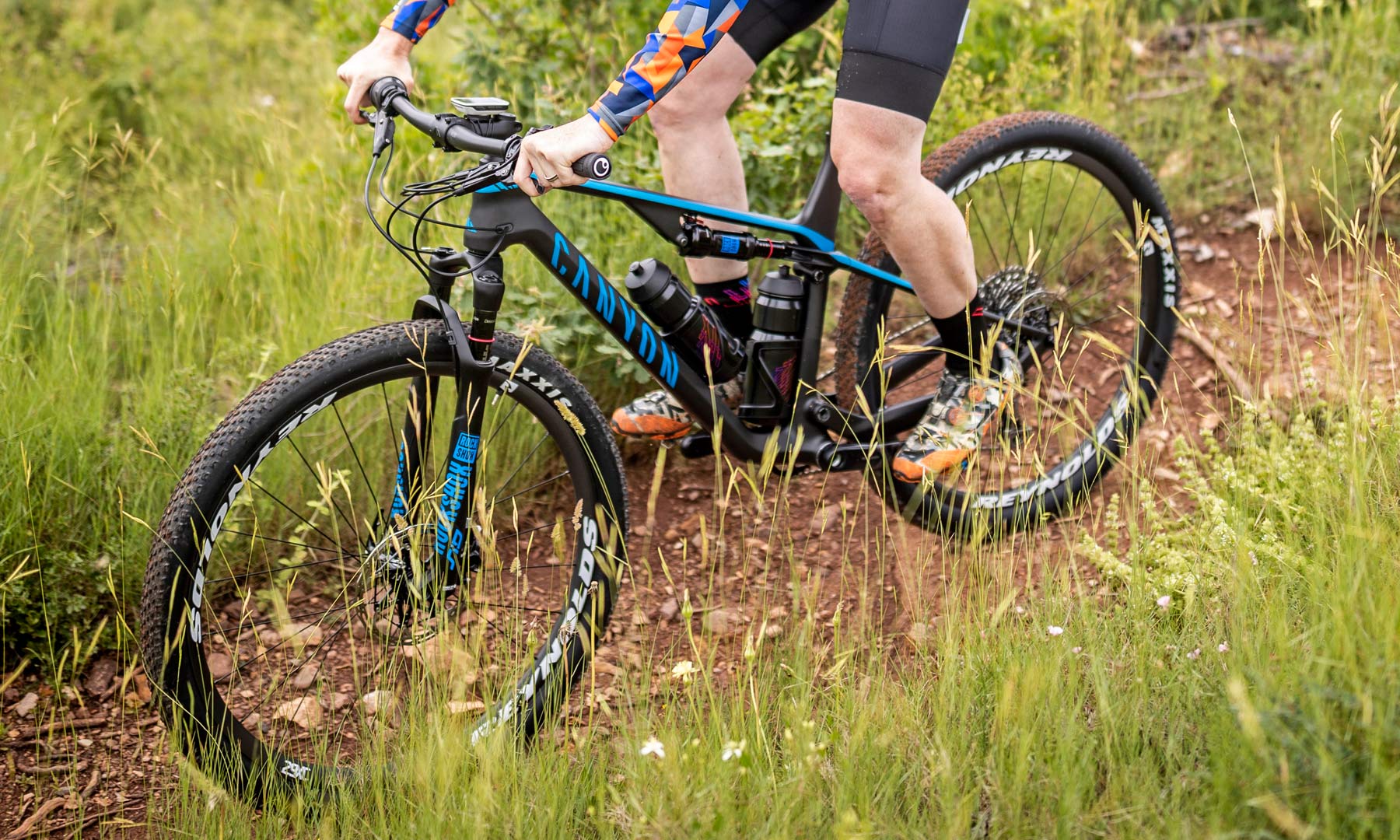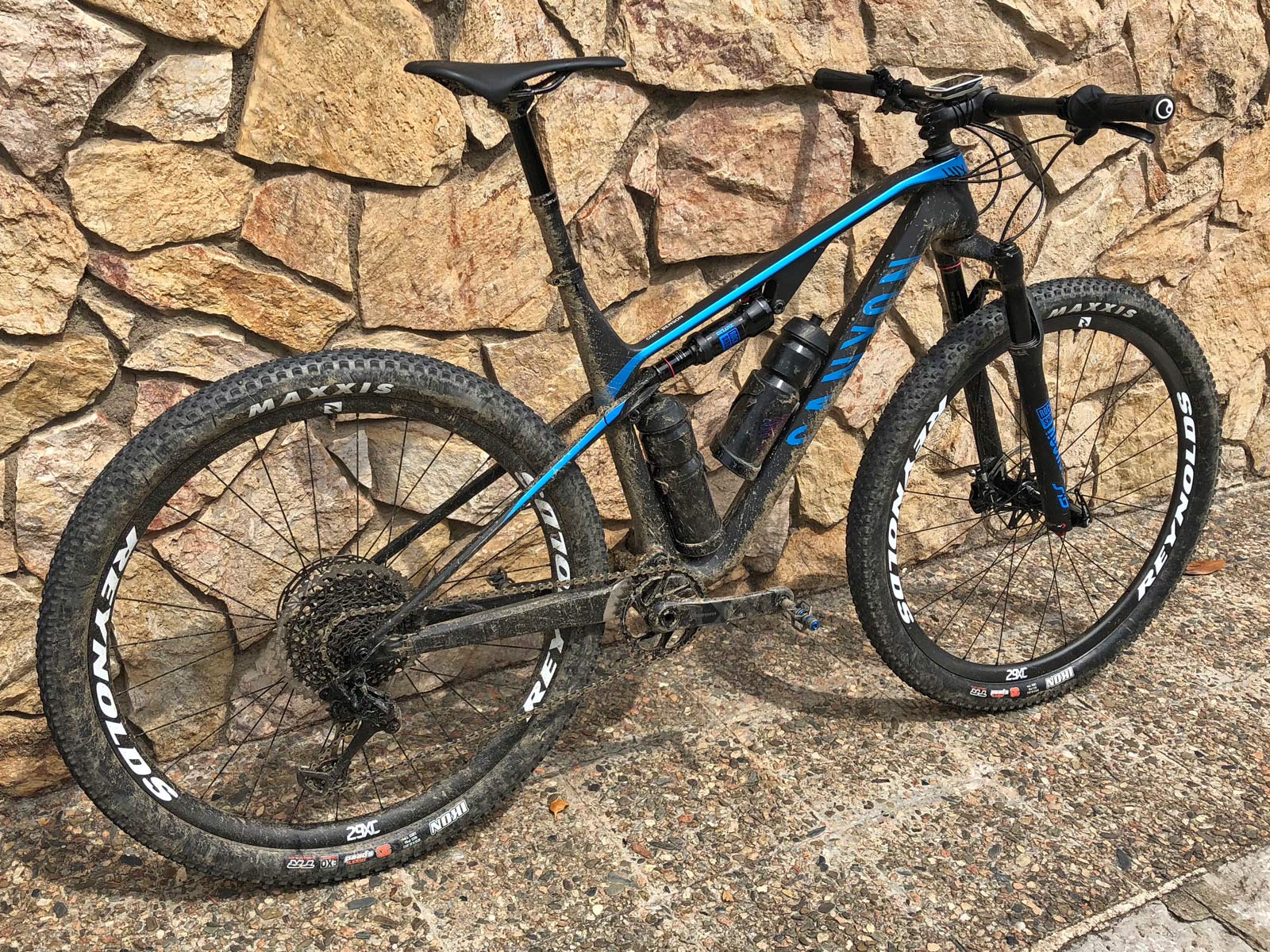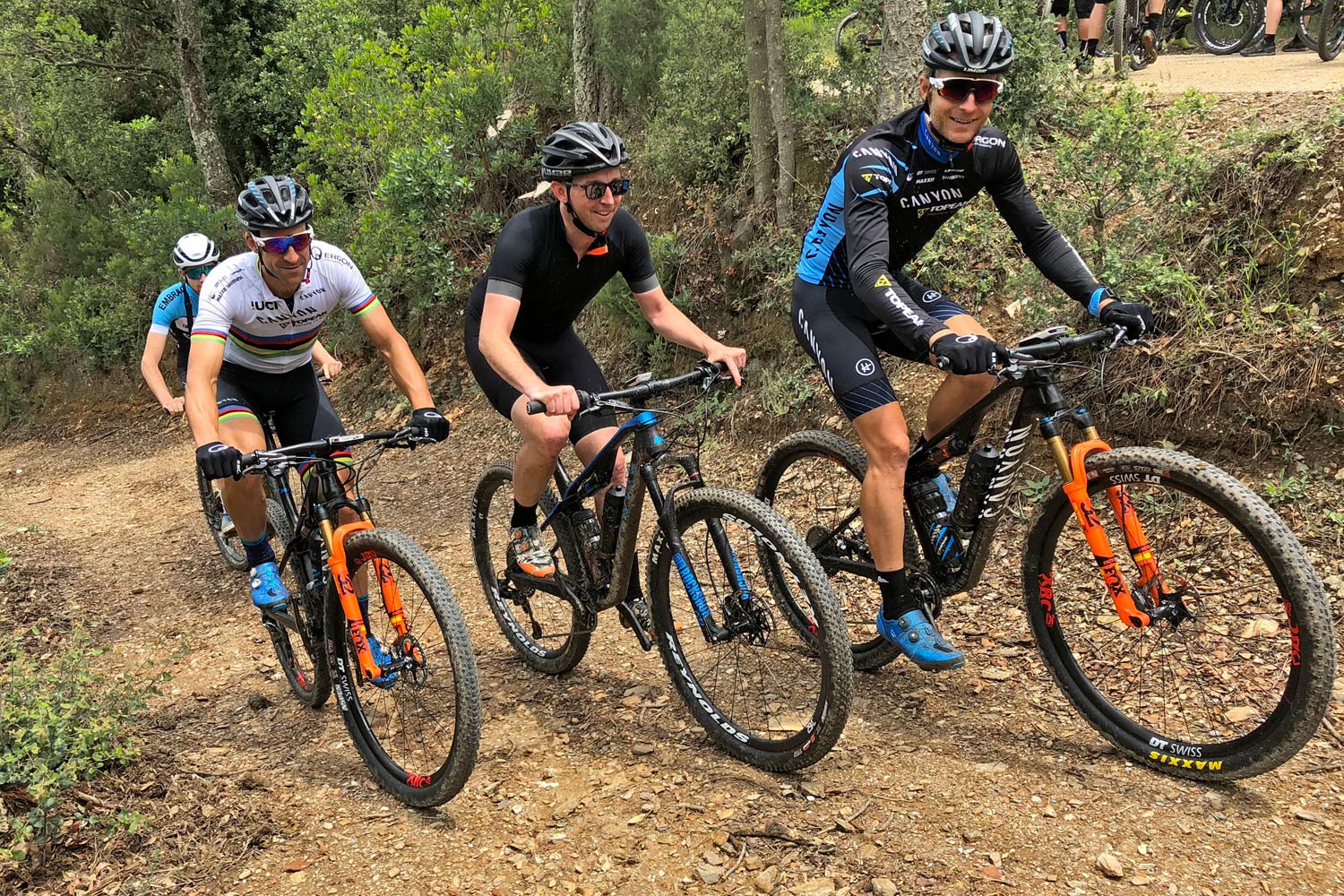Back just before Sea Otter Europe, I had a chance to put in some kilometers riding Canyon’s latest carbon Lux XC race full-suspension bike outside of Girona. On rides spent chasing XC pros like Pauline Ferrand-Prevot, and marathon heavy-hitters like Alban Lakata & Kristian Hynek, I got an inside look at the bikes XCO & XCM development, while testing the bike out on Catalonia’s long climbs & rocky descents.
Canyon Lux 100mm carbon full-suspension XC race bike
Built to be a proper pro-level cross-country race bike I was in good company in Spain, riding with some fast racer types. In its 100mm travel XC race guise front & rear, the bike is a light and efficient climber and there were plenty of steep hardpack forest road climbs to zip up on my test rides.
But coming down was going to be even more interesting on the new Lux. Built to tackle modern technical XC race courses it claims to be a capable descender with a low shock leverage ratio that allows lower shock air pressures. Then its suspension linkage design delivers a progressive end of the stroke to prevent bottoming out on even the roughest terrain.
Canyon suggests setting the bike up with anywhere from 20-25% sag, saying the two ends of that provide a much different feel depending on user preference – 20% for a tight XC racer feel or 25% for more of a supple trail riding feel. So I spent time riding in both to see how big a difference it really is.
Riding Impressions
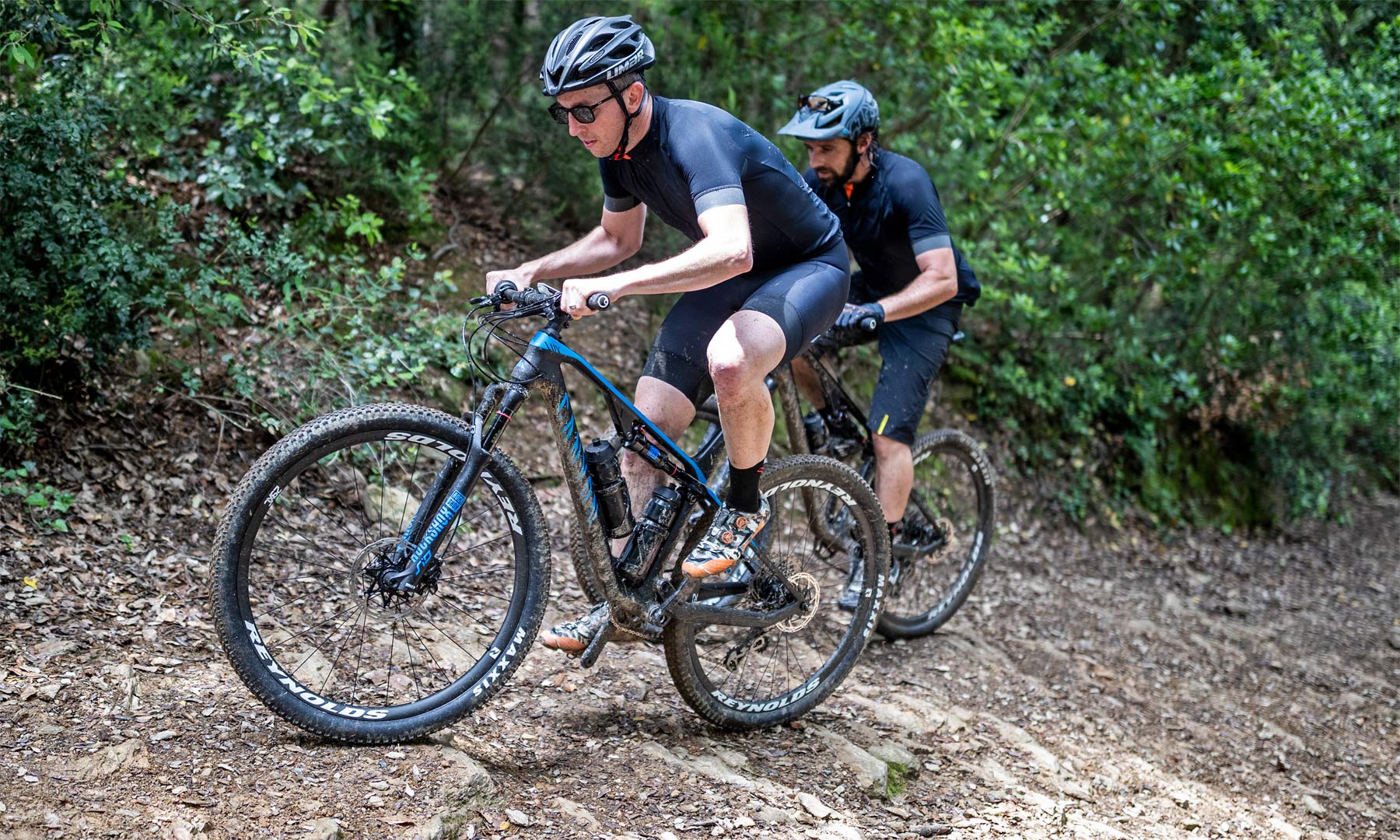
Climbing, the bike benefits from a lot of anti squat that really made the lockouts only necessary on the steepest and smoothest climbing. At 20% sag I only used the lockout on asphalt, while at 25% I popped it on occasionally for the steepest hardpack climbs too.
Everyone of Canyon’s Lux specs includes a combined remote lockout lever, the OneLoc on the RockShox bikes. That lockout uses a short lever that felt overwhelmed on our test bikes with new cables, making it fairly difficult to press even with clean cable routing.
With its single pivot perfectly aligned with the single chainring, when you pedal smoothly up hill, the rear wheel simply sticks to the ground without any real noticeable bobbing sensation. That let me keep the suspension open so the rear wheel could track over rough climbing. A simple pause in the pedal stroke was all it took for the early supple suspension travel to become more active as I rode up over obstacles, delivering excellent grip.
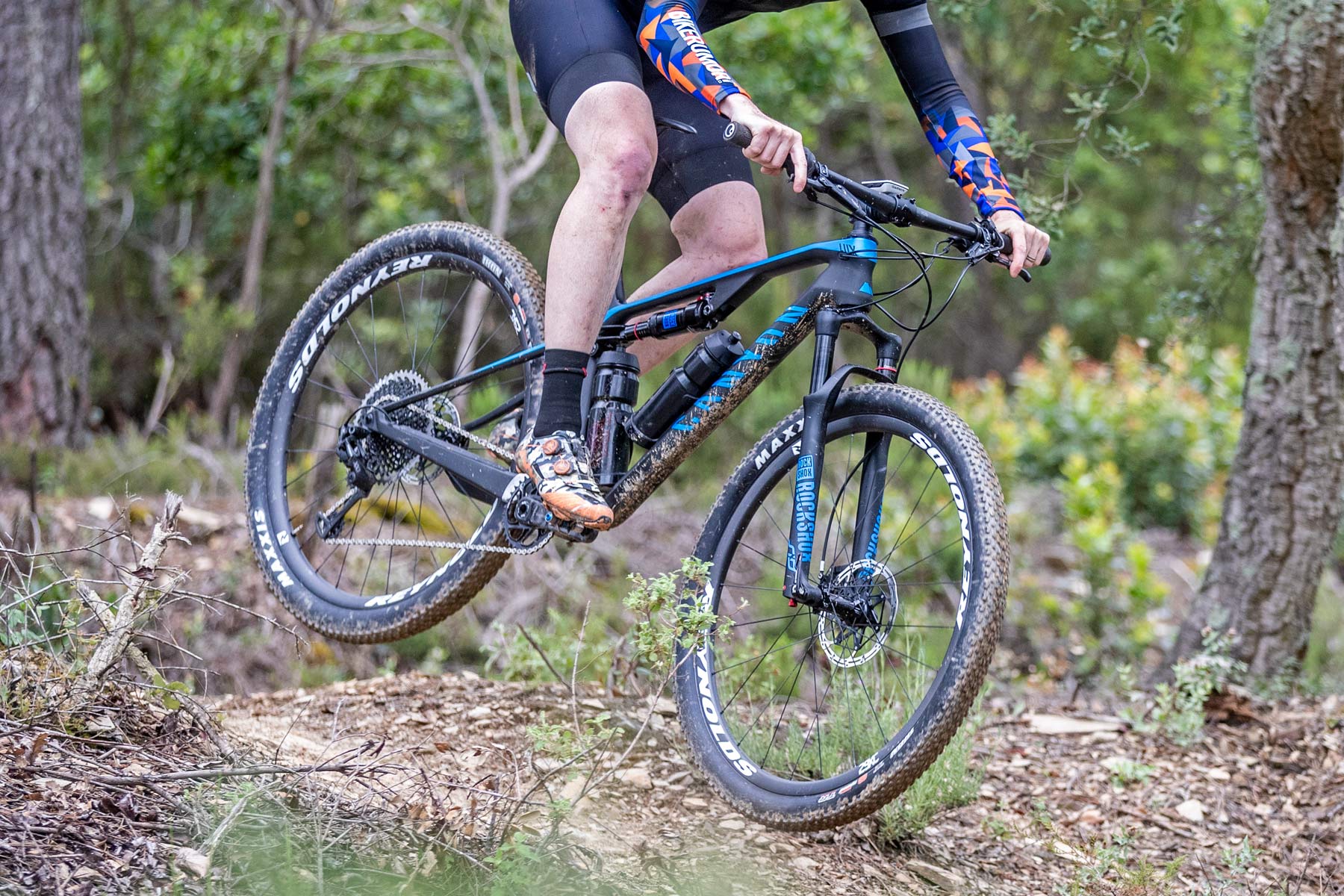
Rolling singletrack and descending the bike through rock gardens was a fun as promised. Even as a light bike, the updated modern trail bike-inspired geometry makes the Lux stable and predictable when you point it downhill. Here the switch between 20 & 25% sag really felt like a big shift. While the stiffer suspension setup felt like you might be bouncing a lightweight bike through choppy sections of trail, the shift to 25% sag felt like it brought out a sweet spot in the middle of the bike’s travel where trail riding became plush. I routinely found myself chasing rainbows, as I followed marathon champ Alban Lakata taking the ‘more creative lines’ down some of Girona’s technical rocky trails, often linking one rocky outcropping to the next. Even though the suspension felt stable while pedaling up climbs, I didn’t get a strong sense of feedback at the pedals when I rode through rough sections of trail.
With the more open suspension setup the bike felt more plush, like it was moving deep through its travel. Interestingly enough, it wasn’t. What actually was happening is that the progressive nature of the suspension allowed the middle of the stroke to feel plush, while I never really got close to bottoming out the travel. With either 20 or 25% sag, I still ended up only using about 80-85% of the travel even when pushing the bike pretty hard through technical sections. At the same time, I pushed through about 95% of the SID’s fork travel.
The lesson there is that I could probably run even a little less air in the shock if I want to use the remote lockout a bit more, or I could drop the one bottomless token that was in the shock to start with. Or I can just be confident that when I come around the corner on a trail with a big drop in the middle of it, I can just lean back on the XC bike and huck it knowing the progressive end of the travel has my butt covered.
Technical Details
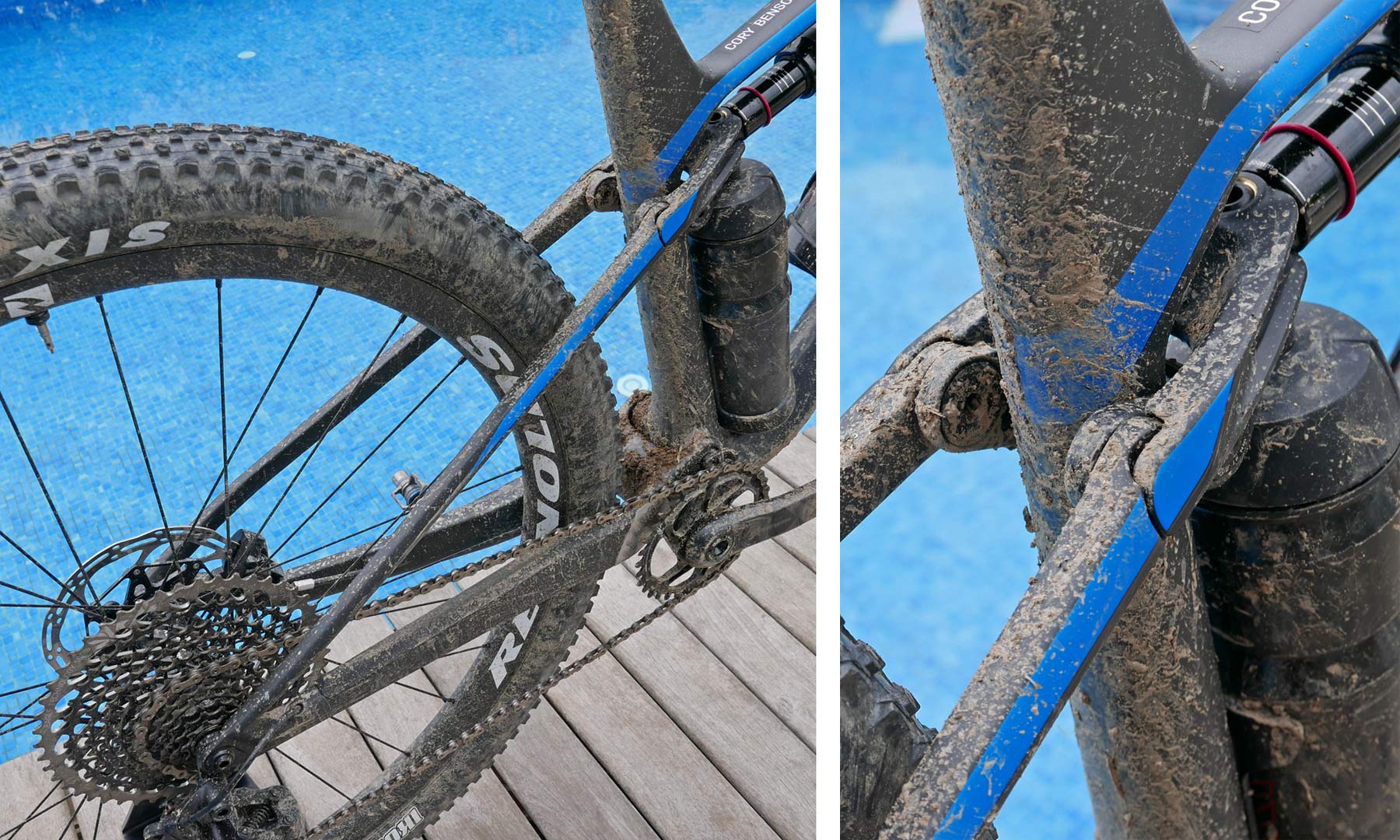 While it does without pivots at the dropout using a flex zone, the Lux fits a pair of linkages at the upper pivot to separate suspension forces going into the frame and driving the shock.
While it does without pivots at the dropout using a flex zone, the Lux fits a pair of linkages at the upper pivot to separate suspension forces going into the frame and driving the shock.
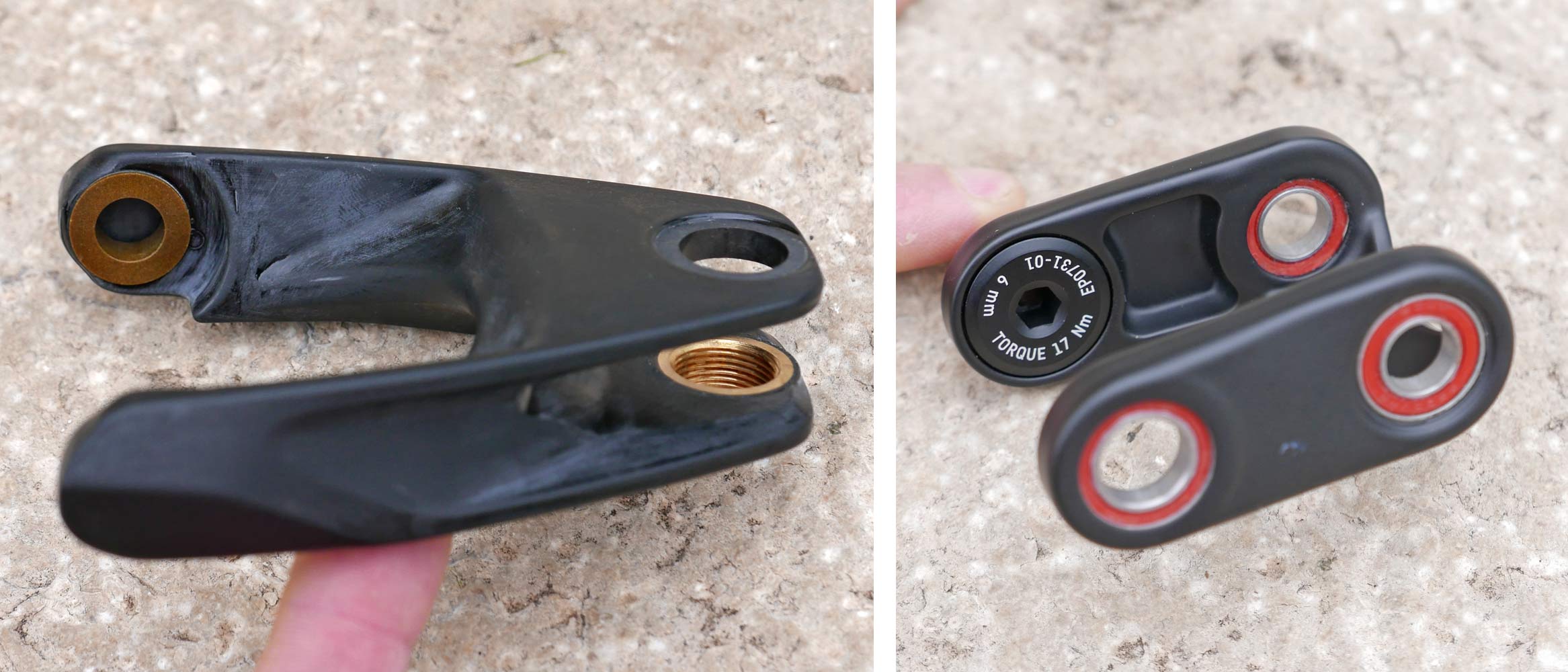 The outer injection molded carbon link drives the shock and spins on bushings. The inner alloy & steel rocker link then rotates on ball bearings packed with a special, resilient grease. In both cases (as with the main lower pivot) the pivots are all pretty exposed to abuse, so hopefully the sealing Canyon promises will hold up as they say. Those bushings are easy enough to replace if needed. But outside of popping the seals off and regreasing them, Canyon says it will just sell a new metal rocker with new bearings once it is time to replace its bearings.
The outer injection molded carbon link drives the shock and spins on bushings. The inner alloy & steel rocker link then rotates on ball bearings packed with a special, resilient grease. In both cases (as with the main lower pivot) the pivots are all pretty exposed to abuse, so hopefully the sealing Canyon promises will hold up as they say. Those bushings are easy enough to replace if needed. But outside of popping the seals off and regreasing them, Canyon says it will just sell a new metal rocker with new bearings once it is time to replace its bearings.
 Overall, the move to a 1x specific setup was done in a big part to allow the use of larger, and wider set bearings, which promise big stiffness improvement without extra weight. Of course going to only single chainring setups also made the small chain guide possible, and allowed the suspension designers to really maximize the efficiency of how this bike climbs, even with the shock wide open.
Overall, the move to a 1x specific setup was done in a big part to allow the use of larger, and wider set bearings, which promise big stiffness improvement without extra weight. Of course going to only single chainring setups also made the small chain guide possible, and allowed the suspension designers to really maximize the efficiency of how this bike climbs, even with the shock wide open.
 Canyon’s development team talked up the significance of fitting two large bottles in even small bikes, and I didn’t complain while riding is hot weather. Not a huge fan of riding with anything on my back, that’s a lot of room for a tool carrier setup as well. Interestingly there was almost no extra space in the front triangle of my Large frame than Pauline Ferrand-Prevot’s small (above). While frame reach was bigger on my bike, the bottom bracket to seattube pivot is the same across bike sizes, with my larger bike just getting a taller seatpost extension (and very similar standover as the smaller bikes.)
Canyon’s development team talked up the significance of fitting two large bottles in even small bikes, and I didn’t complain while riding is hot weather. Not a huge fan of riding with anything on my back, that’s a lot of room for a tool carrier setup as well. Interestingly there was almost no extra space in the front triangle of my Large frame than Pauline Ferrand-Prevot’s small (above). While frame reach was bigger on my bike, the bottom bracket to seattube pivot is the same across bike sizes, with my larger bike just getting a taller seatpost extension (and very similar standover as the smaller bikes.)
 To make those bottles fit, the shocks are all tucked tightly up into the underside of the toptube. That means the shocks all get special remote linkages (maybe why the remote lockout lever felt stiff?) for everything to fit. Adjustment of the shock becomes tight. Getting a pump on the valve was not an issue, but adjusting the lockout and even squeezing my fat fingers into adjust the shock rebound is a bit tricky. And you won’t want to change shocks.
To make those bottles fit, the shocks are all tucked tightly up into the underside of the toptube. That means the shocks all get special remote linkages (maybe why the remote lockout lever felt stiff?) for everything to fit. Adjustment of the shock becomes tight. Getting a pump on the valve was not an issue, but adjusting the lockout and even squeezing my fat fingers into adjust the shock rebound is a bit tricky. And you won’t want to change shocks.
The bike also includes Canyon’s Impact Protection Unit (IPU) in the toptube that limits bar rotation to keep from damaging the frame with a brake lever or fork leg cap.
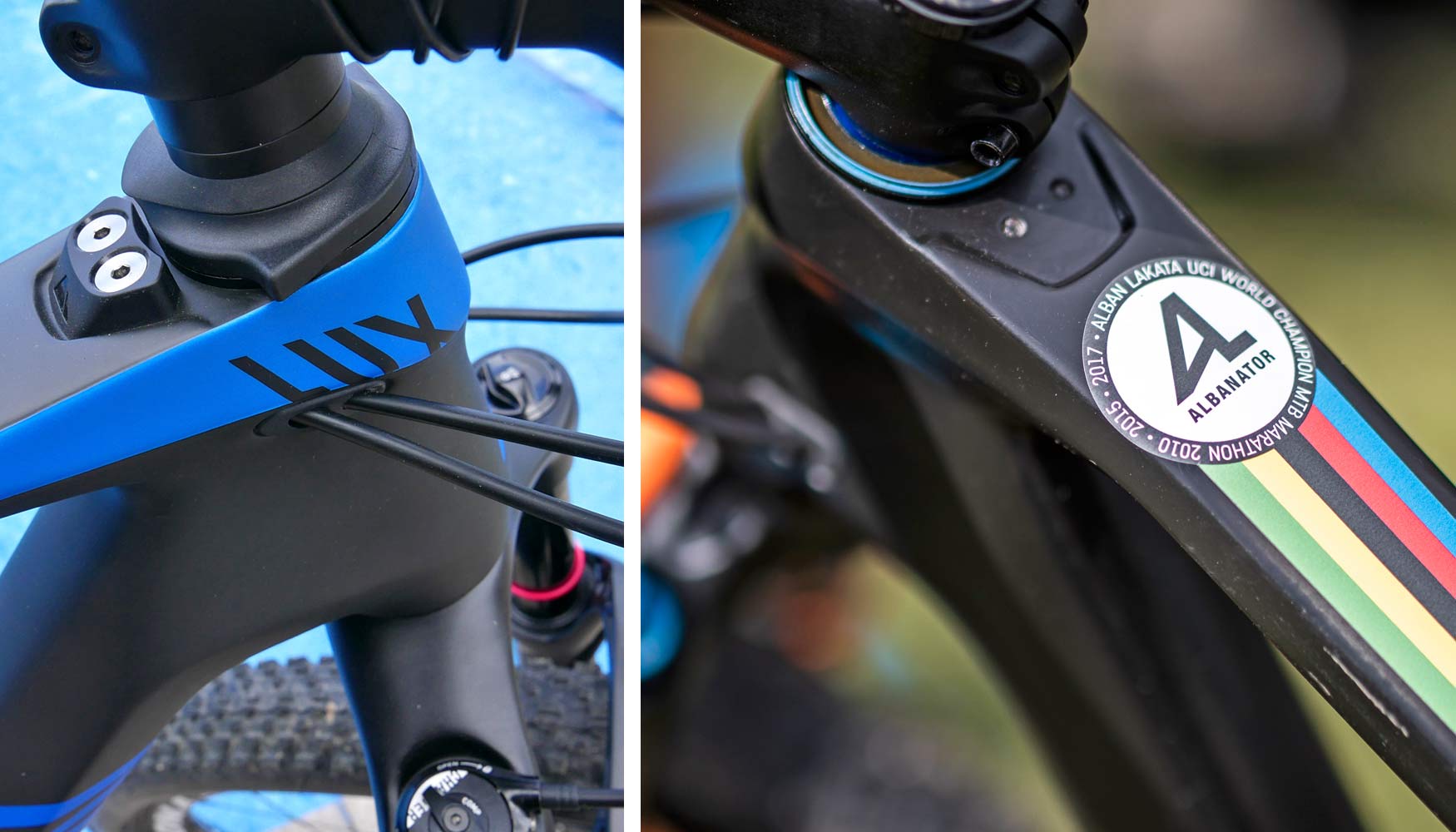 It doesn’t usually get noticed while riding, but it is a weird feeling while starting at a trail head or trying to maneuver super slow or even track stand. Also, it eventually will break away in a proper crash, so its ultimate use in a race spec mountain bike is questionable. But have no fear, you can be like a World Champion and just unbolt the thing, and maybe even
It doesn’t usually get noticed while riding, but it is a weird feeling while starting at a trail head or trying to maneuver super slow or even track stand. Also, it eventually will break away in a proper crash, so its ultimate use in a race spec mountain bike is questionable. But have no fear, you can be like a World Champion and just unbolt the thing, and maybe even slaw slam your stem.
Actual Weight
 The bike I spent time testing was the World Cup level Canyon Lux CF SLX 9.0 Pro Race, which sells for a cool $6000/5600€ with an XX1 Eagle build, carbon Reynolds Black Label wheels and a claimed weight of 10kg/22lb. XC carbon wheels for the same end weight, and availability right now.
The bike I spent time testing was the World Cup level Canyon Lux CF SLX 9.0 Pro Race, which sells for a cool $6000/5600€ with an XX1 Eagle build, carbon Reynolds Black Label wheels and a claimed weight of 10kg/22lb. XC carbon wheels for the same end weight, and availability right now.
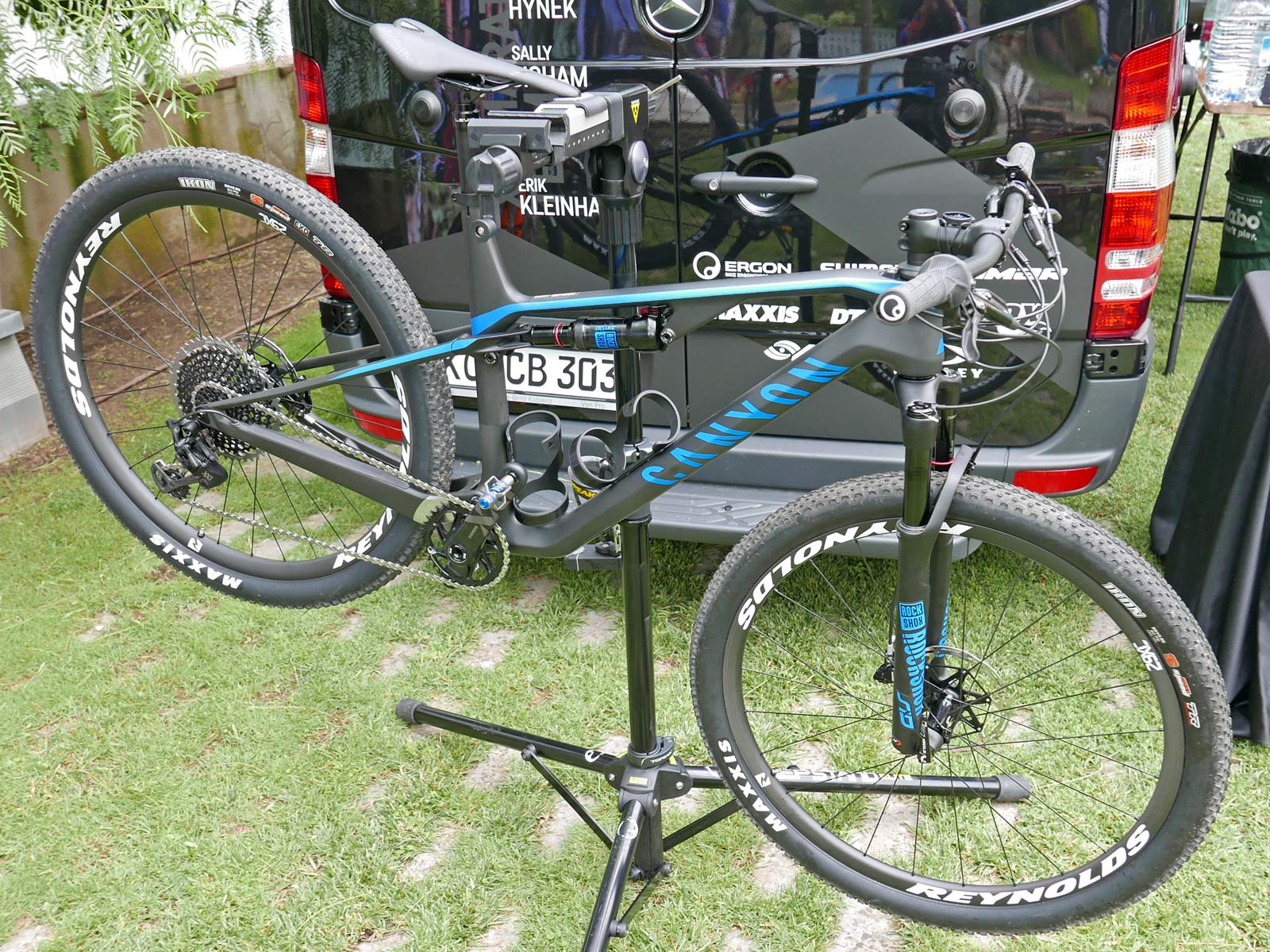 In the end my size Large test bike with a 280g pair of Crankbrothers Eggbeater 3 pedals, a pair of 48g a piece glass fiber reinforced Sideloader cages, and a few grams for a tiny Garmin mount, weighed in ready to ride at 10.575kg/23.31lb with sealant in the tires.
In the end my size Large test bike with a 280g pair of Crankbrothers Eggbeater 3 pedals, a pair of 48g a piece glass fiber reinforced Sideloader cages, and a few grams for a tiny Garmin mount, weighed in ready to ride at 10.575kg/23.31lb with sealant in the tires.
Note: As a reader has pointed out below, we do not recommend hanging your bike from the saddle with the dropper compressed. It is a good way to introduce air into the IFP of your dropper, and harm its regular operation.
Final Thoughts

The new Lux is the latest XC race bike developed to take on more technical race courses. Throw in the included dropper post and with that comes the ability to just be a regular mountain bike, capable for a lot of general purpose cross-country trail riding, and ready to pin a number on to go fast too. The ability to fit a couple of full-sized bottles, even in the smallest frame is nice added benefit. But it’s the 1x only drivetrain and efficient pedaling, short travel suspension that are probably what will shape buyer decisions.
Again, I rode the lightweight CF SLX model that pairs 100mm of fork travel to 100mm of rear wheel travel. If you opt for the less expensive carbon of the CF SL bikes, you will get 110mm of travel in slightly stiffer forks and end up with a more trail-capable bike with the same pedaling efficiency. Between the two frame+fork options and the broad range of ride feels available depending on sag, this short travel XC bike can be a lot of different things to a lot of different mountain bikers.
